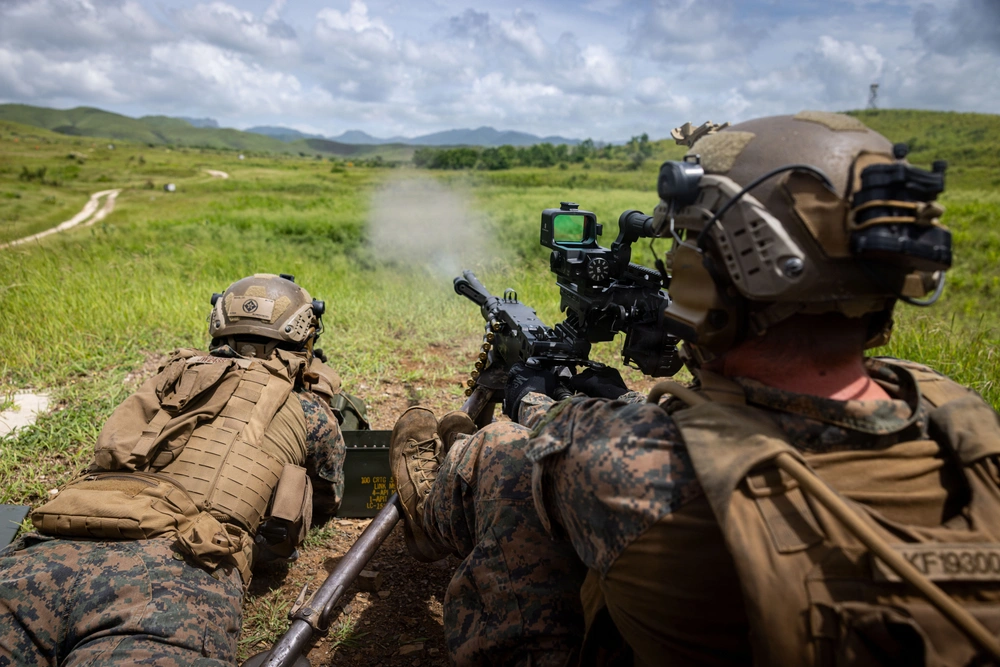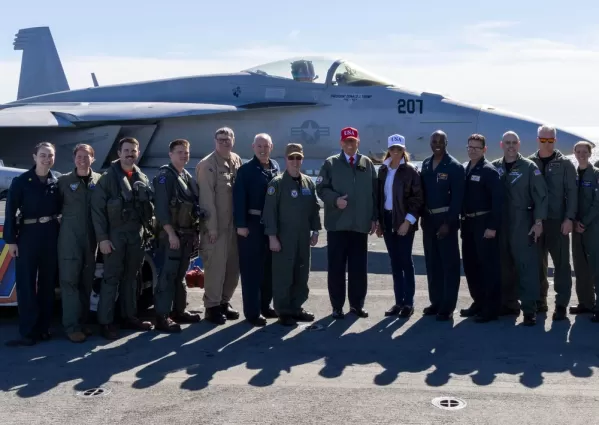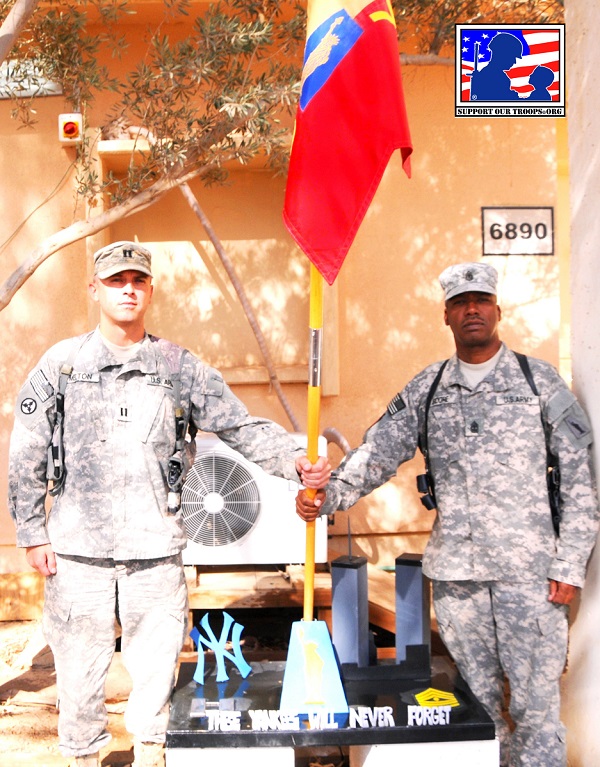- Details
- Hits: 138

PUERTO RICO, (October 22, 2025): U.S. Marine Corps Lance Cpl. Kevin Fine, right, a machine gunner with Weapons Company, Battalion Landing Team 3/6, 22nd Marine Expeditionary Unit (Special Operations Capable), engages a target with an M2A1 .50-caliber machine gun during a live-fire range on Camp Santiago, Puerto Rico. U.S. military forces are deployed to the Caribbean in support of the U.S. Southern Command mission, Department of War-directed operations, and the president’s priorities to disrupt illicit drug trafficking and protect the homeland. (U.S. Marine Corps photo by Sgt. Nathan Mitchell)
- Details
- Hits: 632

UNITED STATES, ATLANTIC OCEAN (October 5, 2025):Commander, U.S. 2nd Fleet. President Donald J. Trump and First Lady Melania Trump pose for a photo aboard the Nimitz-class aircraft carrier USS George H.W. Bush (CVN 77) after the Titans of the Sea Presidential Review. The Titans of the Sea Presidential Review is one of many events taking place throughout the country to showcase maritime capabilities as part of the U.S. Navy’s 250th birthday. America is a maritime nation. For 250 years, America’s Warfighting Navy has sailed the globe in defense of freedom. U.S. Navy photo by Mass Communication Specialist 2nd Class Pierce Luck.
- Details
- Hits: 1591

The events of 9/11, like Pearl Harbor before it, began a global military and political realignment. As one would expect, it started out adhering to the long-standing global structural perceptions, misperceptions, and practices. The Abraham Accords achieved in President Trump’s first term began a fundamental shift from the old ways in the Middle East, which America’s adversaries traditionally used to breed trouble at the expense of the locals.
But God did not put us here to be perpetually miserable. As in Eden, He intended happiness and prosperity for His creations. And believing in this, the fresh, new thinking brought in last year by the new Trump Administration has in but a few short months brought us post-9/11 to an entirely new global configuration, pursuing prosperity and aligned along common sense interests of the countries involved as opposed to ancient ethnic grievances, division and geopolitical manipulation by the known bad actors. Masks are coming off, and the wearers recognized for what they are, making choices and dealings clearer and simpler for the others, because they can base them on true, not fake, motivations and objectives. In short, a long-standing morass of deceit and manipulation is quickly being set right.
And through all of this, your troops have done their part keeping everyone at home safe. When requested they now even patrol the streets at home to help take out the garbage. And they rapidly deploy all over the world to deter or suppress small brushfires before they grow into huge wildfires.
- Details
- Hits: 8711

Wake Island. South Pacific. In this photo by Air Force Senior Airman Audree Campbell, A-10 Thunderbolt II aircraft fly in formation over Wake Island, a tiny island with an extremely dark past. During World War II, Wake was the scene of some of the worst atrocities committed by Japanese troops against innocent civilians and POWs.
Wake Island is a coral atoll in the Pacific Ocean located 2,300 miles west of Honolulu and 1,500 miles northeast of Guam. Originally part of Micronesia, the atoll is currently under the administration of the American Department of the Interior. The island is shaped like a crescent with a 4.5-mile reef surrounding a deep-water lagoon. For years prior to the war, Wake was a lonely outpost used mostly by Pan American Airlines as a transit stop for long flights over the Pacific.
The Japanese conducted two amphibious assaults, one on 11 December 1941 (which was rebuffed) and another on 23 December, which led to the Japanese capture of the atoll. As they did elsewhere in the Pacific, the Japanese used the 98 POWs for slave labor and subjected them to inhuman conditions. Many prisoners were placed on a "hell ship" to be transported to a prison in Japan occupied China. Encouraged by the ship’s captain, the POWs were given too little food and water in unsanitary conditions in the ship's holds, and they were systematically beaten and tormented. Five were executed during the voyage.
- Details
- Hits: 7537

San Antonio, Texas. (June 21, 2025): In this photo by Senior Airman Gabriel Jones, Actor Tom Cruise greets Air Force Chief Master Sergeant Gilda Alexander, command chief of Joint Base San Antonio and U.S. Army Colonel Will B. Freds, deputy commander of the 502nd Air Base Wing during a leadership reception. Cruise visited with JB San Antonio leadership and service members to thank them for their sacrifices in support of the mission.
The reception comes at the end of filming of the hit movie "Mission Impossible: The Final Reckoning", the eighth installment of the "Mission Impossible" franchise. Hollywood has a long-standing relationship with the U.S. military for assistance with filming war movies dating back to World War II. Military participation is essential to ensure that no sensitive information is inadvertently disclosed and for historical accuracy. For example, Hollywood costume departments consult with active-duty military to make sure patches and insignia are correct on uniforms and that standard military operations are accurately portrayed.
- Details
- Hits: 7706

Five Hills Training Area, Mongolia. (June 16, 2025): They are descendants of a warrior culture that conquered the known world in 1223 A.D. In this photo by Army Staff Sergeant Christopher Stelter, 1st Lieutenant Davonta Vaughn and interpreter Fa Ganbaatar speak to Mongolian Armed Forces Staff Sgt. Dadaasuren Tumen Ulzii during foot patrol training. The Americans are participating in Khaan Quest, an annual exercise designed to promote regional peace and security. The U.S. is working with Mongolia to foster stronger democratic institutions, including supporting citizen participation, and promoting a more market-driven economy.
The warrior spirit of the people of Mongolia is legendary. In 1206, Genghis Khan was able to unite the various Mongol tribes into a fighting force that terrorized their enemies. Today, the Mongolian armed forces consist of three branches, a ground force, a construction and engineering unit, and special forces. The current ground component has roughly five hundred tanks, 650 infantry fighting vehicles, and over five hundred mobile air defense systems. Most of them are old Soviet Union models designed between the late 1950s to early 1980s. Instead of heavy combat, its mission is focused on peacekeeping operations and humanitarian assistance.


